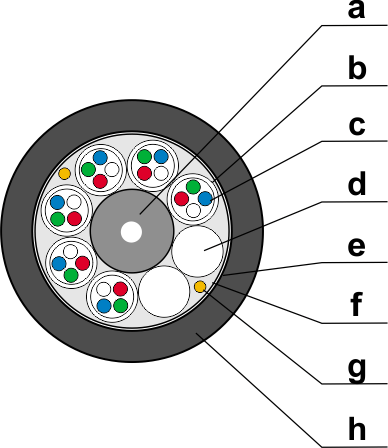Orders placed before 4 p.m. are processed on the same day.
The Tele-Fonika Z-XOTKtsd 12J cable features a multi-tube construction – loose tubes helically stranded around a central FRP (fiber-reinforced plastic) strength member.
In this version, only one tube is active, containing 12 single-mode fibers, while the remaining tubes act as fillers.
A mini-tube with a 1.8 mm diameter is used, which reduces the overall cable diameter to 8 mm and significantly lowers its weight. As a result:
The bending radius is reduced by about 30% compared to the 2.4 mm tube version
The cable weight is nearly cut in half
The cable is easier to install (especially for blowing into microducts) and cheaper to transport
Although the cable is mechanically less robust (lower tensile strength), its reduced weight and flexibility compensate for this difference.
Due to its small diameter (for a multi-tube cable), it is an excellent choice where duct space efficiency is crucial (e.g., Orange networks).
The standard fiber used is single-mode G.652D (SM 9/125 µm), which offers:
Very low attenuation
Minimal dispersion
Excellent transmission parameters
Originally designed for long-haul networks, single-mode fibers are now standard in metropolitan and access installations – over 90% of fiber deployments use this type, even at distances below 0.5 km.
Tele-Fonika cables utilize fibers from renowned manufacturers (e.g., Sumitomo or Corning). On request, other fiber types can be used, such as G.657.A2 (with enhanced bending performance).
The Z-XOTKtsd 12J (1x12)/1.8 cable is designed for outdoor installations, especially:
In fiber conduits Ø32 and Ø40
In primary ducts Ø110 (for blowing installations)
In areas requiring full dielectric construction – suitable for installation near LV, MV, and HV power lines
Key features:
Resistance to UV, moisture, and temperature variations
Dry core sealing system and hydrophobic gel in the tube
Small diameter and lightweight design – easy to transport and install
Perfectly suited for blowing techniques
Meter marking and optional customized labeling
 | Cable Structure – Z-XOTKtsd a: Central strength member – FRP dielectric rod with or without polyethylene coating b: Tube – loose tube with optical fibers filled with hydrophobic gel c: Optical fiber – single-mode (J), G.652D d: Filler – polyethylene filler rod e: Cable core – all tubes and fillers stranded around the central strength member f: Core sealing – dry sealing system g: Ripcord – 2 threads for sheath cutting h: Outer sheath – black polyethylene jacket |
High-quality single-mode fibers (Sumitomo/Corning) ensure low signal attenuation
Weather and UV resistance
Multi-tube construction enhances durability and fiber protection
Compact, lightweight design for easy installation
Ideal for blowing into telecom ducts
The Tele-Fonika Z-XOTKtsd fiber optic cable is a modern, efficient solution for professional fiber networks. It ensures high transmission quality, resistance to external factors, and easy installation, making it an excellent choice for advanced telecom infrastructure.
We have made every effort to ensure that the above data is correct, but we do not guarantee that the published information does not contain errors, which, however, cannot constitute the basis for any claims.